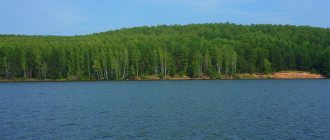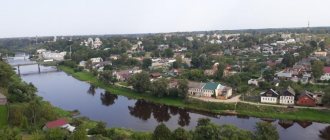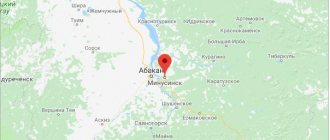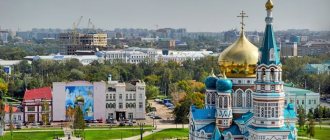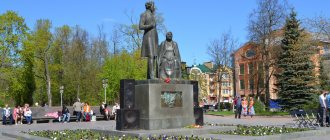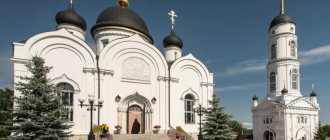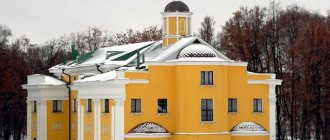Content
- 1 Millionaire cities with more than 1 million people 1.1 Perm
- 2.1 Berezniki
- 3.1 Solikamsk
- 4.1 Nytva
Solikamsk is a historically important point in the salt industry
Solikamsk is the third city in the region in terms of size and population with 166.55 km² and 94,628 inhabitants. However, the population density is low: 568.17 people/km². For comparison, in Moscow it is 9 times more, and in the capital of the region it is two and a half times. The history of the city's development is connected with the salt industry. It was here that, back in 1430, the first primitive technological installation for the extraction and processing of salt was installed. At the beginning of the 17th century, thanks to its favorable geographical location and industrial development, it was one of the largest cities in the modern territory of the Perm Territory. There were more than 350 households and several dozen trading enterprises, production cooperatives and private small shops.
The Perm region owes a lot to Solikamsk - one of the most famous and recognizable national metaphors. Everyone knows the expression “Permyak salty ears.” It appeared due to the fact that local men carried heavy bags of salt on their shoulders. This made their ears red, swollen and very noticeable. In the center of Perm, they even recently installed a funny monument with giant ears, and taking a photo with it is a matter of honor for every tourist who comes to the city.
Today, the industry of Solikamsk is closely connected with neighboring Berezniki: they form a single economic region. One of the largest enterprises in the sector is Uralkali, which specializes in mining. Salaries in the region are the national average, and the unemployment rate, thanks to the abundance of industrial and commercial enterprises, is minimal and amounts to only 1.8%.
Medium-sized cities 20-100 thousand people
Solikamsk
Population 95,191 people (2016).
Chaikovsky
Population 83,056 people (2016).
Kungur
Population 66,311 people (2016).
Lysva
Population 63,083 people (2016).
Krasnokamsk
Population 53,964 people (2016).
Chusovoy
Population 45,546 people (2016).
Dobryanka
Population 33,194 people (2016).
Chernushka
Population 32,982 people (2016).
Kudymkar
Population 31,007 people (2016). Until December 1, 2005, it was the administrative center of the Komi-Permyak Autonomous Okrug.
Vereshchagino
Population 22,261 people (2016).
Wasp
There are other meanings of this name
Population 21,143 people (2016).
Gubakha
Population 20,645 people (2016).
Perm is the only metropolis and the largest city in the region
Perm is one of the most important Ural cities, a major economic, educational, scientific and cultural center. This is a real metropolis with a fairly high density - 1315 people/km². It is characterized by the main problems of a big city: traffic jams during rush hour, crowds on central streets, poor performance of public utilities and poor environmental conditions. It is the most polluted city in the region. Every year, more than 50,000 tons of harmful substances are released into the atmosphere, which includes about 400 types of waste. The dirtiest areas are Industrial and Ordzhonikidze, which account for about 70% of the total share of pollution. The most significant surge in population growth occurred from the thirties to the eighties of the last century. In 50 years the population increased from 122,712 to 1,028,000: almost tenfold. This is due to the construction of the famous Motovilikha plant, the development of industrialization and the construction of many industrial enterprises. This provided good career prospects and opportunities for developing professional potential, which attracted a large number of young people to the region, who formed the base of the modern population.
The city continues to retain its industrial importance today. In 2006, it became the best in microclimate for the development of entrepreneurship and small business, and in 2012 it was included in the ranking of the most attractive and promising industrial cities in the country. Despite the fact that Chelyabinsk and Yekaterinburg are traditionally considered the industrial cities of the Urals, Perm is the leader in terms of production volume in the region. There are more than 25 large industrial enterprises here, making an important contribution to the economy of the region. The capital of the region has many financial, trading and manufacturing companies that provide its infrastructure. Major industries include:
- mechanical engineering;
- electric power industry;
- chemical and petrochemical industries;
- heavy metallurgy;
- food industry;
- wood processing;
- oil and gas refining industry.
This is a large scientific and educational center. There are 13 universities, about 10 branches of higher educational institutions from other regions and more than 20 institutions of secondary specialized education. From a tourist point of view, the remarkable development of the old center, with a large number of interesting buildings from the 19th century, is of interest. Also in the vicinity of Perm there are several sanatoriums that are distinguished by a high level of service and use the natural health factors of the region in treatment. Of particular importance among them are mineral waters, which are used for drinking treatment and balneotherapy.
Small towns up to 20 thousand people
Nytva
Population 18,863 people (2016).
Kizel
Population 16,173 people (2016).
Krasnovishersk
Population 15,644 people (2016).
Wow
Population 14,151 people (2016).
Alexandrovsk (Perm region)
There are other meanings of this name, see Alexandrovsk
Population 13,108 people (2016).
Gornozavodsk
Population 11,511 people (2016).
Gremyachinsk
Population 9,208 people (2016).
Okhansk
Population 7,098 people (2016).
Usolye
Population 6,110 people (2016).
Cherdyn
Population 4,686 people (2016).
Chermoz
Population 3,566 people (2016).
Permian
The largest city in the Perm region is the capital of the region - Perm. It was founded in 1723 (according to other sources - in the middle of the 17th century) by Vasily Tatishchev in a strategic location at the intersection of land and water trade routes. The area was rich in copper and silver ore. On May 4, 1723, the Yegoshikha copper smelter began operating, contributing to the expansion of the settlement.
A powerful impetus for development was the construction of a railway line to the city in 1878. In 1916, the first Ural University was organized here. According to official statistics, at the end of 2021, the city had a population of 1,048,005.
Today, among all the cities of the Perm region, Perm has the most powerful industrial and scientific potential. There are large factories in the metallurgical sector, military-industrial complex, petrochemical industry, mechanical engineering and instrument making.
see also
- Perm region
- Cities of Russia
| [ + ] Cities by regions of Russia | |
| Cities of the North-West (NWFD) | St. Petersburg (and its cities) • Leningrad region (historical Staraya Ladoga) • Arkhangelsk region • Vologda region • Kaliningrad region • Karelia • Komi • Murmansk region • Nenets Autonomous Okrug • Pskov region |
| Cities of the Volga region (Volga Federal District) | Bashkortostan • Volgograd region • Kalmykia • Kirov region • Mari El • Mordovia • Nizhny Novgorod region • Orenburg region • Penza region • Perm region • Samara region • Saratov region • Tatarstan • Udmurtia • Ulyanovsk region • Chuvashia |
| Cities of Southern Russia (SFD) | Sevastopol (including Inkerman) • Republic of Crimea • Adygea • Astrakhan region • Krasnodar region • Rostov region |
| Cities of the North Caucasus (NCFD) | Dagestan • Ingushetia • Kabardino-Balkaria • Karachay-Cherkessia • North Ossetia - Alania • Stavropol Territory • Chechen Republic |
| Cities of the Urals (Ural Federal District) | Kurgan region • Sverdlovsk region • Tyumen region • Khanty-Mansi Autonomous Okrug - Yugra • Chelyabinsk region • Yamalo-Nenets Autonomous Okrug |
| Cities of Siberia (Siberian Federal District) | Altai Republic • Altai Territory • Irkutsk Region • Kemerovo Region • Krasnoyarsk Region • Novgorod Region • Novosibirsk Region • Omsk Region • Tomsk Region • Tyva • Khakassia |
| Cities of the Far East (FEFD) | Amur Region • Buryatia • Jewish Autonomous Region • Trans-Baikal Territory • Kamchatka Territory • Magadan Region • Primorsky Territory • Sakha (Yakutia) • Sakhalin Region • Khabarovsk Territory • Chukotka Autonomous Region |
| see also | Cities of the DPR, LPR, Transnistria, South Ossetia • Regions of Russia • Cities of Russia |
Berezniki
It is the second largest city in the Perm region. The population of the settlement is 145,115. It was founded as a salt-making center at the turn of the 16th-17th centuries. However, a powerful stimulus for expansion was the construction of a soda factory by merchant I. I. Lyubimov in 1883 - one of the first in the Russian Empire. A workers' settlement was built next to the enterprise, designed in accordance with all urban planning rules.
Today Berezniki is the largest center for the production of potash fertilizers in Russia. Over many years of mining, voids have formed underground, which periodically collapse. In the photo of the city of the Perm Territory, taken from a height, the formed failures are clearly visible. Some are in the middle of residential areas.
Coronavirus statistics in the Perm region December 6, 2021
Over the past 24 hours, 690 new cases of COVID-19 have been confirmed in the Perm region.
The total number of infected people in the Kama region reached 144,926. Over the past 24 hours, 8,316 PCR tests for the new coronavirus infection were carried out in the region.
To date, in the Perm region, 277 patients are in serious condition in hospitals repurposed for treatment of COVID-19. Of these, 128 are connected to ventilators. Since the beginning of the pandemic, 6,960 people have died from the new coronavirus infection in the Kama region.
As of the morning of December 6, in the Perm Territory, 1,078,337 people were immunized against COVID-19 with a single-component vaccine or the first dose of two-component drugs. 837,656 residents completed the two-component vaccination course.
Sights, architectural monuments, interesting places
The most famous tourist attractions in the Perm region are not in the cities, but outside them. These are, first of all, natural monuments: huge tracts of taiga forests, mountain rivers, mysterious caves and, of course, amazing rocky outcrops. It is not for nothing that travelers call this region the land of rocks and stones. Gray, Talkative, Written Stone - all these sites attract many tourists every year.
The cities of the region also have a lot of interesting things: numerous museums, temples and architectural monuments. Fans of beautiful architecture and ancient estates should definitely visit Perm, Usolye, Lysva, Solikamsk and Kungur. It is best to stay in the “capital” of the region - Perm. The city is located in its central part, and from it it will be convenient to make radial trips and excursions to different parts of the region.
Chaikovsky
The city of power engineers was founded in 1955. Over the next fifty years, its population grew to 84,000 people. The birth of the settlement is associated with the construction of the large Votkinsk hydroelectric power station on the Kama River. By the way, on the site of Tchaikovsky there was the Osinsky Preobrazhensky Monastery, founded at the beginning of the 17th century, and the village of Saigatka.
Architecturally, it embodies the ideas of Soviet specialists about an ideal city. The residential sector is divided into microdistricts with multi-storey buildings, among which there are many “Khrushchev” buildings. The blocks are interspersed with parks and squares. Foreign partners were also invited to Tchaikovsky, in particular from the GDR and Turkey. The second most important industrial facility in the city after the VGES is the Silk Fabric Factory.
Krasnokamsk
The city of Krasnokamsk is the administrative center of the municipal district. It received the status of an urban settlement. The population as of 2014 is 53,697 people. The city is located on the banks of the Kama. The distance to Perm is approximately 35 km along the highway. The city is connected to the regional center by railway and waterways. The Perm region is a center for the production of pulp and paper products. The Goznak factory is located in Krasnokamsk. This enterprise is a leading one in Russia; it specializes in the production of valuable, printed, drawing and documentary types of papers. The city-forming enterprise is a pulp and paper mill. It produces school notebooks, albums, printing and writing paper. Krasnokamsk produces the widest range of paper intended for offset printing. It meets all standards of both Russia and Europe. In addition, the city has established the production of metal mesh made from synthetic fibers.
Gubakha
Gubakha is the administrative center of the urban district. It is located in the center of the Kizelovsky coal basin. The distance to Perm is 219 km along the highway. The Chusovaya-Solikamsk railway line runs through Gubakha. Within the city limits, the land area is 4297 hectares. Of these, 1,648 hectares are built up; 195 hectares are allocated for parks, squares and other green spaces. The length of city streets is 102 km. According to 2014 data, the population is 21,658 people. The city is known for the fact that there are karst phenomena on its territory. These are primarily caves and caves. Like other cities in the Perm region, Gubakha is famous for its industrial production. The largest city-forming enterprise is OJSC Metafrax. It is engaged in the production of chemicals. These are formaldehyde, methanol, pentaerythritol, methenamine, urea-formaldehyde resins, sodium formate, process oxygen, etc. There is another large enterprise in the city - the Gubakha Coke and Chemical Plant. It produces products such as coal varnish, ammonium sulfate, coke, tar, benzene and much more.
Solikamsk is a city with a constant outflow of population
The population of Solikamsk is constantly falling. By 2021, it was close to 94 thousand people. The city literally stands on the potash industry. Large deposits of potassium have been developed for many years, providing high export potential. The small city supplies more than 60 countries around the world with its products. The average salary here is higher compared to other cities in the region. Local residents do not feel densely populated, since there is none at all, although the density in Solikamsk is high.
In some respects the city can be considered exemplary. For example, local authorities try to increase the number of places in educational institutions every year. There are several secondary specialized institutions, including a pedagogical college.
Healthcare is provided through medical and preventive institutions. The total number of medical staff is approximately 2,600 employees. The city implements various programs related to:
- development of resuscitation and anesthesiology;
- improving reproductive health;
- raising funds for the development of general physical health.
Being a major transport hub, Solikamsk allows you to get to Yekaterinburg by train. Regular service has been established, and there is a bus station serving suburban and intercity routes. Municipal roads are over 300 km long, but not all have good road surfaces. Bus service allows you to get to regional cities; traffic jams are rare. Solikamsk received rapid development due to its historical significance and inclusion in tourist routes, but few tourists come here, which becomes a plus in relation to comfort.
The example of the population of the Perm Territory shows that even a regional city can be improved. On the other hand, large and small settlements in the Russian Federation remain characterized by infrastructure problems and a shortage of personnel in medical institutions, and specifically the Perm region is faced with a constant outflow of the working population.

